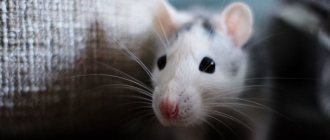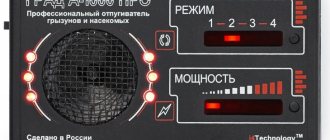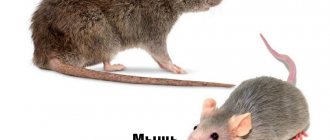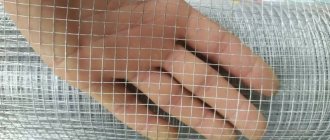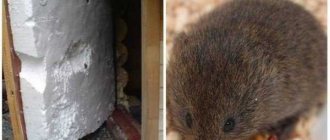Mice are harmless, cute rodents with a body length of up to 7 cm. Everyone imagined seeing this miracle with small pink ears in an apartment, however, a more comfortable home for them is a place where people very rarely visit, for example, a dacha. That’s when they show their negative side - they build nests, construct a network of passages, damage property, destroy supplies, and much more. If this is not counteracted in any way, rodents will take over the area forever. Therefore, owners of non-residential country houses need to know how to deal with mice in the country. All existing methods are discussed further in the article.
Causes of mice, damage from rodents
Pests usually enter a greenhouse in winter and early spring. The reason is simple - mice try to stay close to comfortable conditions where there are food sources. If the room is insulated, seedlings are usually grown here, which attract rodents. If the building is used for business, zealous owners begin to grow all kinds of vegetables and herbs for sale in winter. The mice feel great here - warm, light, full of food.
Rodents can cause significant damage - chew root vegetables (beets, carrots, potatoes and radishes), destroy young sprouts of greenery. If peppers and tomatoes are grown indoors, when pests invade, spoiled fruits will inevitably be found.
Not only gnawed vegetables, but also passages in the ground will help determine the presence of mice in a greenhouse. “Apartments” of pests pose a danger to plants - they dry out the soil and injure delicate roots. In times of hunger, mice will gladly destroy young roots, which will lead to the death of the above-ground part.
Repel mice from the site: 6 ways
The cat is the enemy of the mouse, the friend of man
A time-tested way to get rid of a mouse is to get a cat.
The cat is a reliable ally in this difficult struggle. She doesn't just hunt mice. Cats leave their droppings and fur on the property, thereby spreading the smell. The mice won't disappear completely, but their numbers will be reduced so much that you won't notice them anymore. True, it takes time for a cat to achieve a noticeable result. Perhaps more than one summer season.
Plants that will help drive mice away from your dacha
The smell of mint, tansy, chamomile, white sweet clover, wormwood, and coriander is very unpleasant for mice.
They are generally sensitive to strong odors. It would be a sin not to take advantage of this! We push rags moistened with mint oil (cologne or ammonia) into the burrows. We place tansy or chamomile flowers on the beds. We plant coriander (aka cilantro) under the trees. And the mice will no longer want to live in such conditions. Red and black elderberries are excellent at repelling mice. Its roots produce hydrocyanic acid, a toxic substance for mice. Therefore, where elderberry grows, mice do not settle. Plant an elderberry bush near your shed or compost pile. The number of fluffy and other pests will decrease before your eyes. Many gardeners tie young fruit trees with elderberry branches for the winter to protect them from mice. However, remember that a person may be allergic to elderberry. Before using it against mice, it would not hurt to test yourself and your children for sensitivity to this allergen.
In addition, rodents do not like plants whose seeds cling to their skin. Burdock, burdock, and blackroot (rat beetle) greatly spoil the life of mice, so they avoid them. And black root, on top of everything else, is terribly poisonous. It is dangerous both fresh and dry. That is why in the old days rat traps were placed in attics and basements to preserve supplies.
Repellent devices
Modern technologies offer their own option on how to get rid of mice in the country or at home.
We are talking about ultrasonic repellers. While working, they produce ultra-high frequency sounds. People, dogs and cats can’t hear them, but rodents have a hard time. Many repellers do not require an outlet and operate on batteries. There are solar-powered garden rodent repellers. They are designed to work outdoors, stick into the ground and change the frequency to make it difficult for mice to adapt.
In addition to ultrasonic ones, electromagnetic and combined repellers are also available for sale. But they are mostly intended for indoors, and cope well with rodents living in walls, ceilings and partitions.
Perhaps this method of combating furry pests is good for everyone, except for one thing - you will have to fork out the cash, because good devices are not cheap.
Homemade repeller will help get rid of mice
Don't want to spend your hard-earned money? You can test a mechanical repeller made from a plastic bottle or aluminum can. It's easy to do it yourself. In a 1.5 liter plastic bottle (or jar) we make several U-shaped cuts. We bend the blades and attach the bottle to the metal pin vertically or horizontally. It turns out to be a pinwheel. We stick several of these pinwheels into the ground throughout the area. The wind spins the bottle's blades, creating vibration. The vibration goes through the pin into the soil. Rodents are not friends with vibration and will prefer to move away.
Fighting with chemicals
The simplest and most effective method to get rid of voracious “tenants” in closed ground is to use chemicals. The only warning is that you should not resort to toxic agents if dogs or cats roam freely in the area. Mice may leave the room before dying; consuming a poisoned pest can result in serious poisoning or even the death of a pet.
Among the drugs that effectively destroy pests, the following can be noted:
- "Rat Death" The drug is packaged in bags or applied to grains. To kill rodents, spread poisonous bait in the greenhouse and renew it as it disappears. A signal that the fight has ended in favor of the summer resident - the drug remains untouched.
- "Graincide." Cereal grains are saturated with a toxic substance. It is better to place the bait on tin lids, thick cardboard or plywood. This will help you track how quickly the grains disappear and determine when the mice will disappear from the room.
- "Zookoumarin." One of the best drugs. The grains are coated with a toxic substance that causes almost instant death. It is used like other preparations - just spread it out in different places on the beds and regularly update the bait until the rodents disappear completely.
When using medications, it is recommended to follow simple rules. Handle products only with gloves, and wash your hands and face thoroughly after use. Do not allow children into the room during the treatment period. If there are animals on the property and it is not possible to use other options for getting rid of pests, do not leave the windows open, it is advisable to give the pets to friends for this period or limit free movement around the plot.
What methods can you use to fight mice?
There are many effective ways to control rodents in the countryside. Moreover, they are all divided into only two large groups:
- Repellents: repellent plants, special devices. Their task is to repel mice and rats from our area without killing them. They simply create an uncomfortable environment for rodents. And there is nothing left to do but go in search of another territory.
- Destructive agents: baits, mousetraps, traps. They fight rodents tooth and nail. Everything is clear here: the number of mice is reduced due to their death.
Which option will work and how much depends, first of all, on the number of animals. But we should not forget that rodents are quite intelligent mammals and know how to adapt. Therefore, it is best to alternate methods and means or use several at once.
Home remedies for mice
If there are mice in the greenhouse, and it is not possible to use poisonous drugs, you can try to clean the room with repellers. Simple remedies will successfully deal with mouse colonies, but you will have to arm yourself with patience - traditional methods act much more slowly than aggressive chemicals.
Folk remedies:
- Roll the moss into small balls, soak each of them with Vishnevsky ointment. Place repellers in the greenhouse, if mouse passages are found, put several baits in the holes. The smell of the product does not disappear for a long time, but after 3-5 days it is recommended to prepare a fresh batch of repellers.
- Take several cotton pads and pour plenty of tar or turpentine. Place repellents with a pungent odor near beds favored by rodents. Update every three days.
- In the summer, stock up on burdock. The prickly balls cling to mouse fur, creating numerous inconveniences for uninvited “neighbors.” Scatter the prickly plant heads throughout the greenhouse and the mice will try to leave the uncomfortable home.
If possible, you can plant daffodils in a greenhouse. Rodents do not like the smell of the bulbs of these plants. Peppermint, hazel grouse and daisies planted in the beds will not appeal to them either. Even if there is no place to plant aromatic plants, you can simply use fresh herbs - place bunches near the vegetable crops that mice love.
Banal traps can also be used against mice in a greenhouse, especially if the mouse family is small. Seductive baits - fried bacon, seeds, pieces of hard cheese. The main thing is to use several mousetraps at once, inspect them in a timely manner and destroy any rodents that come across. Armed with patience, you can completely get rid of the gluttonous “guests” in a few weeks.
Prevention
In order not to remove rodents, it is enough to pay attention to periodic prevention, driving them out and protecting the house. Below are options for how you can repel mice in your dacha.
- Plants - wormwood, tansy, potato or tomato tops.
- Culinary spices - cloves, cilantro.
- Petroleum products - kerosene, turpentine.
Since voles, shrews, and house mice have a highly developed charm, they can be scared away by strong unpleasant odors. But over time they get used to it, so to increase efficiency and enhance the aroma, it is better to change its sources.
A more modern repeller, which can be used even on land, is an ultrasound generator. You will have to pay a hefty sum for this device, but today it is the most practical and effective.
Important! Not only mice, but also people should be afraid of ultrasound and poisons, so they must be used in accordance with the manufacturer’s instructions.
Just like electronic mousetraps, the generator can be autonomous, powered by batteries, or stationary, powered by the mains. The advantage of ultrasound is that it penetrates into burrows and passages, due to which furry pests are repelled over the entire area.
How to scare away mice at the dacha with folk remedies or factory devices, everyone decides for themselves. It is better to carry out regular preventive measures so that you do not have to kill even harmful, but living creatures, and also distribute poisons that may harm your pets.
Signs of the presence of rodents in the dacha area and in the house
Inexplicably damaged roots, bark, food and things. The incisors of rodents leave two distinct marks - shallow parallel grooves.
Presence of excrement. Mouse droppings look like elongated grains, and rat droppings look like spindle-shaped piles of different sizes.
Footprints. Mice and rats move along beaten paths and prefer the same proven route. Paw prints and fur prints are especially visible on the dusty floors of barns. By following them, you can find a nest of pests.
Dead carcasses. It is unlikely that a rat or mouse accidentally ran into your area and died. If a dead rodent was found, it means that a colony has settled nearby.
Ammonia smell. The unpleasant amber can be heard especially clearly when you enter from the street into a room that has been closed and not ventilated for a long time.
Rusting sounds, grinding and squeaking at night.
Nests of scraps of paper, rags and threads in hidden places in the house. This is not only a sign of the presence of rodents, but also a sign that they will soon have offspring.
The appearance of holes and cracks in baseboards, on the floor, in niches.
Scattered flour, cereals, bags, sacks and packages with signs of chewing.
Sealed packaging and timely sealing of cracks will help save the crop from mice.
At the end of summer - beginning of autumn, rodents set up their nests in all secluded corners of the plot: under fences, in a pile of grass, in heaps of garbage, in attics, in basements, under the floors in country houses...
Types of mice and their characteristics
Most often, two types of mice annoy people:
- brownies;
- voles.
The former spend most of their lives in human housing, the latter live in nature during the warm season, but with the onset of cold weather they seek shelter in houses, barns and garages.
House mouse
The house mouse is a dark gray or gray-brown rodent. The body length is from 7 to 9 cm, the length of the tail is slightly more than half the length of the body. These are very prolific animals. Living in favorable conditions (for example, in a warm house), mice reproduce throughout the year, bringing 6 to 12 litters, each with from 3 to 12 pups.
Home
Despite the name, the house mouse can live in a field, garden or vegetable garden. But still, these rodents prefer to live close to people, settle comfortably in the house, and go outside from time to time.
Vole
Field mice are slightly larger than their domestic relatives. The rodent's body length can reach 12 cm, the tail makes up 70% of the body length. The fur of voles is lighter, most often ocher-gray. These rodents live in meadows, fields, in bushes, and sometimes settle in garden plots.
With the onset of winter, voles can enter the house in search of warmth and food and stay there until spring.
What is the greenhouse effect?
Short answer:
The greenhouse effect is a process that occurs when gases in the Earth's atmosphere trap heat from the sun. This process makes the Earth much warmer than it would be without an atmosphere. The greenhouse effect is one of the things that makes the Earth a comfortable place to live.
Watch this video to learn about the greenhouse effect!
How does the greenhouse effect work?
As the name suggests, the greenhouse effect works... like a greenhouse! A greenhouse is a building with glass walls and a glass roof. Greenhouses are used for growing plants such as tomatoes and tropical flowers.
The inside of the greenhouse remains warm even in winter. During the day, sunlight enters the greenhouse, which warms the plants and the air inside. It is colder outside at night, but the inside of the greenhouse remains quite warm. This is because the glass walls of the greenhouse trap heat from the sun.
The greenhouse traps heat from the sun during the day. Its glass walls trap the sun's heat, keeping plants in the greenhouse warm—even on cold nights.Credit: NASA/JPL-Caltech
.
The greenhouse effect works much the same way on Earth. Gases in the atmosphere, such as carbon dioxide, trap heat like the glass roof of a greenhouse. These heat-trapping gases are called greenhouse gases.
During the day, the Sun shines through the atmosphere. The Earth's surface is heated by the sun. At night, the Earth's surface cools, releasing heat into the air. But some of the heat is retained by greenhouse gases in the atmosphere. This is what keeps our Earth warm and cozy at an average of 14 degrees Celsius.
The Earth's atmosphere traps some of the sun's heat, preventing it from escaping back into space at night. Credit: NASA/JPL-Caltech
.
How do people influence the greenhouse effect?
Human activity changes the Earth's natural greenhouse effect. Burning fossil fuels such as coal and oil releases more carbon dioxide into our atmosphere.
NASA has observed an increase in the amount of carbon dioxide and some other greenhouse gases in our atmosphere. Too much of these greenhouse gases can cause the Earth's atmosphere to trap more and more heat. This causes the Earth to warm up.
What reduces the greenhouse effect on Earth?
Just like a glass greenhouse, an earthen greenhouse is full of plants! Plants can help balance the greenhouse effect on Earth. All plants, from giant trees to tiny phytoplankton in the ocean, absorb carbon dioxide and release oxygen.
The ocean also absorbs a lot of excess carbon dioxide from the air. Unfortunately, increasing carbon dioxide in the ocean changes the water, making it more acidic. This is called ocean acidification.
More acidic water can be harmful to many marine life, such as some shellfish and corals. Warming oceans due to too many greenhouse gases in the atmosphere may also be harmful to these organisms. Warmer water is the main cause of coral bleaching.
This photo shows a bleached brain coral. The main cause of coral bleaching is warming oceans. Ocean acidification also negatively impacts coral reef communities. Credit: NOAA
. ,
How to reduce humidity in a greenhouse
Have you ever walked into a greenhouse in the morning when the sun is rising? You open the door, step forward, and your glasses immediately fog up. You breathe in this fresh, warm air. Water drips and accumulates on all the walls - condensation has accumulated overnight. Even the leaves of plants shimmer with the collected water.
For most people this is a beautiful scene. For farmers it means a little more.
.
Precautions when working with poisoned baits
Instructions for using each Valbrenta rodenticide are provided on the product packaging. And it is important to observe it, as well as safety measures when working with chemicals for pest control. These products are dangerous not only for rodents, but also for humans and pets. Therefore it is required:
Gloves are needed to prevent direct contact with the poison and to prevent pests from smelling a person. Otherwise, they may feel threatened and refuse to eat. It is better to lay out baits and set glue traps in the evening, because... rats and mice become active at night.
Repellent devices
To control pests, you can use modern devices that are sold in stores. They are ultrasonic repellers that act on mice.
Many of them run on batteries, but there are some that need to be connected to an electrical outlet. They need to be buried deep into the ground, which will definitely repel the pest.
In addition to ultrasonic repellers, you can use electromagnetic ones. But they work better indoors, so with their help it is more effective to fight mice that live in walls and partitions.
All these methods are effective, but require financial investments, which not everyone can afford.
What champignons look like that you shouldn’t eat: five signs of dangerous mushrooms
Cyprus will lift mandatory quarantine for tourists from Russia from April 1
The State Duma has banned the removal of stowaway children from transport
Help from professionals
You can usually cope with a mouse infestation on your own. Sometimes it is necessary to combine several methods. But if you cannot get rid of the rodents on your own, or you need to treat a large area, for example, an office building, an apartment building, then it is better to turn to professionals for help.
They combine fast-acting control methods, leaving the mice no chance of escape:
- Mechanical: traps, traps, professional large mousetraps.
- Spraying poisons using a cold and hot fog steam generator. The affected animal spreads poisons on its fur and paws everywhere, including into burrows that are located outside. Thus, the poison spreads to other individuals that were not treated.
- Rodenticidal poisons in baits that lead to internal hemorrhage.
- Gas treatment with fumigators, which can instantly destroy entire populations. Most often used in warehouses and hangars.
- Deration is generally safe for people, but extremely unfavorable for rodents. The premises are treated with special preparations. It is considered the safest and most effective, so it is best if residential premises are treated in this way.
If you want to take help from professionals, pay attention to the methods they use. It may not be only people and animals that will have to leave the house. Sometimes it is necessary to take away all the feed, food, and water supplies.
After treatment, the entire house needs to be washed from ceiling to floor, all textiles washed, etc.
Question to the site author from a reader
How to get rid of rats in the countryside in a simple way?
The easiest way to exterminate rats is with the help of professionals. They will treat the house with products that will destroy rats and will repel them for a long time. In addition, you can constantly use electric and ultrasonic repellers. They emit waves that are unpleasant for rodents, so the rats will choose another habitat. Baits and traps quickly become ineffective because rats are smart animals. The same methods will not work for a long time.
Preventive measures are a guarantee of success in the fight against rodents
To avoid attracting mice to your summer cottage, with the onset of autumn, remove all remnants of vegetables from the garden: cabbage leaves, small carrots, beets, and also burn all garbage. Since this attracts rodents and promotes their breeding. Do not prepare a winter canteen for mice.
Experienced gardeners have long used a rodent repellent such as wormwood. They recommend tying up fruit tree seedlings with wormwood branches in the fall, since pests cannot tolerate the smell of this plant. The stems need to be tied with the crown down and in such a way as not to leave uncovered areas on the trees.
It is also recommended to scatter wormwood branches in the garden, especially in the beds where lilies are planted, the bulbs of which animals love to feast on. The unpleasant smell of the plant will repel rodents.
In addition, in order to save fruit and berry plants from rodents, it is also recommended to plant blackroot bushes around the perimeter of the garden plot or spread out its roots. This is a very poisonous plant, which is also popularly called a mouse killer, and can repel mice. As a preventive measure, experienced gardeners recommend scattering the crushed plant around the trees or watering the ground with a specially prepared decoction of black root. To protect the bushes, you can place some fresh or dried mousegon stalks with leaves among the branches.
Mousegon
You can also plant several red elderberry bushes on the site, the smell of which pests cannot tolerate. In addition, the leaves and branches of the plant are laid out in the expected locations of the animals.
To prevent the appearance of rodents in the garden, you can plant flowers of the imperial hazel grouse, the smell of the bulbs of which can drive away pests.

